EMBL International PhD Programme – Unique in the world and waiting for you!
The EMBL PhD programme is open until 13th October (entry ~Sep 2026):
www.embl.org/about/info/e...
We have three positions in microbial genomics at EMBL-EBI, including one in my group. Please do apply, or if you know anyone that would be interested pass on to them
17.09.2025 15:49 — 👍 19 🔁 40 💬 0 📌 3

Only a few hours left to submit your abstract for a talk at the Machine Learning in Evolutionary Genomics conference in December in Aussois in the French alps!
22.09.2025 14:46 — 👍 2 🔁 2 💬 0 📌 0

Bioinformatician - Uppsala University
Bioinformatician, Department of Organismal Biology, Uppsala University
The @scilifelab.se ancient DNA unit is looking for an bioinformatician placed at Uppsala University. This is a great way to be part of diverse #aDNA research projects as a staff scientist with permanent (!!) employment:
www.uu.se/en/about-uu/...
12.08.2025 07:09 — 👍 44 🔁 55 💬 0 📌 2
1/6 Excited to share our review 🚀
🧬 CRISPR–Cas therapies targeting bacteria!
#MicroSky
15.05.2025 06:53 — 👍 63 🔁 35 💬 1 📌 3
popgen_benchmark Info Page
The PopSim Consortium wants you! Please join us on zoom on May 27 at noon Eastern Time (1600 UTC) to tell us you would like to see in the next version of stdpopsim! DM me for meeting link, or just sign up for our email list: lists.uoregon.edu/mailman/list... (1/3)
14.05.2025 01:04 — 👍 14 🔁 9 💬 1 📌 1
Abstract deadline for @eseb2025.bsky.social extended to 5 May! Still time to submit your abstract for the evolution of microbial pangenomes ⬇️
24.04.2025 08:31 — 👍 8 🔁 4 💬 0 📌 0
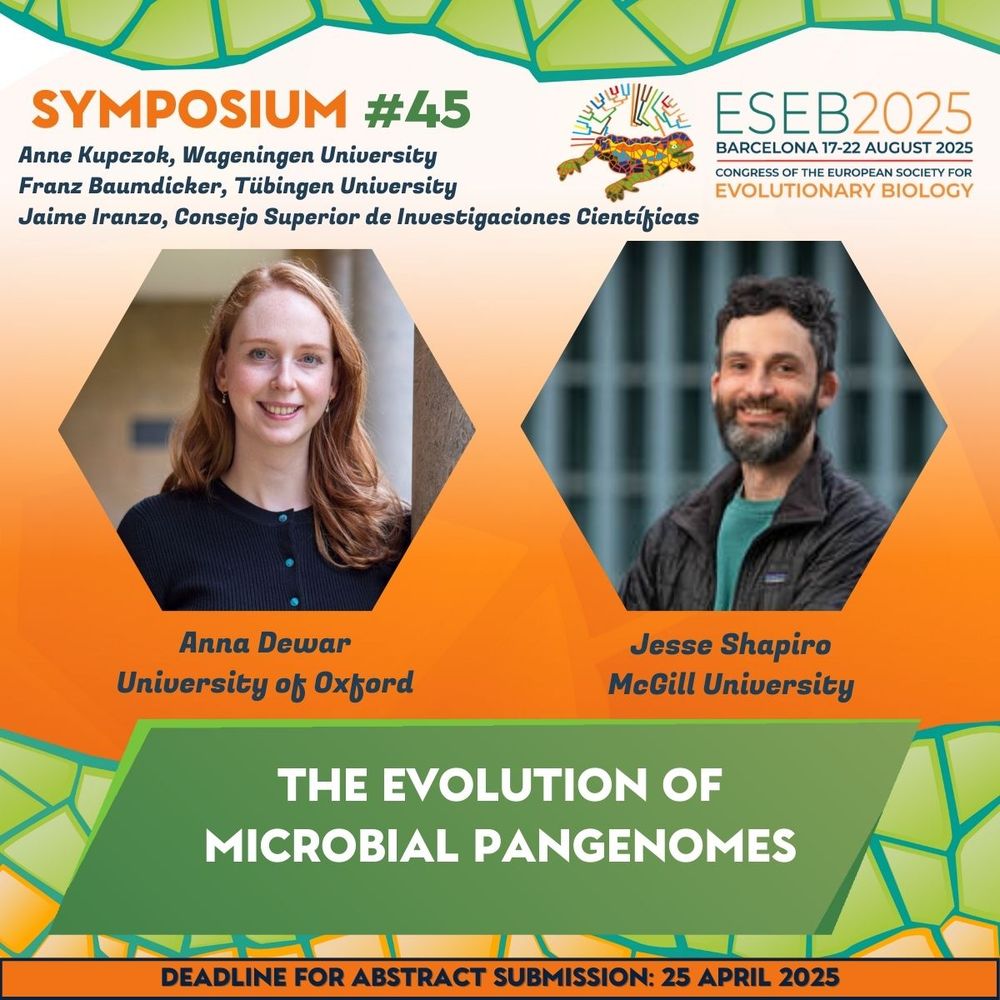
If you are interested in microbial #pangenomes, join us at @eseb2025.bsky.social in Barcelona with @bjesseshapiro.bsky.social and @annadewar.bsky.social
Only two days left to submit your abstract!
eseb2025.com/call-for-abs...
23.04.2025 07:05 — 👍 10 🔁 5 💬 1 📌 1
Join our symposium The evolution of microbial pangenomes at @eseb2025.bsky.social with @bjesseshapiro.bsky.social and @annadewar.bsky.social (co-organized with @fbaumdicker.bsky.social and Jaime Iranzo) eseb2025.com/call-for-abs...
10.04.2025 16:10 — 👍 12 🔁 11 💬 1 📌 2

Accessible, realistic genome simulation with selection using stdpopsim
Selection is a fundamental evolutionary force that shapes patterns of genetic variation across species. However, simulations incorporating realistic selection along heterogeneous genomes in complex de...
stdpopsim v0.3.0 is out! You can now mix and match your simulations of different demographic histories with published distributions of fitness effects along with gene annotations, and you can even throw in sweeps for good measure. Check out the new manuscript for more info: doi.org/10.1101/2025...
24.03.2025 18:29 — 👍 37 🔁 22 💬 0 📌 0

Using genomics to explore the ecology and evolution of plant-associated microbial populations and communities? 🌿
Submit an abstract by March 11 and join us in Cologne this July for #ISMPMI2025! We serve cool science + cold German beer 🍻 Join the party: buff.ly/uqEfN6O
04.03.2025 17:30 — 👍 19 🔁 7 💬 0 📌 1
Save the date for the second conference on Machine Learning for Evolutionary Genomics Data!
25.02.2025 13:11 — 👍 3 🔁 1 💬 1 📌 0
YouTube video by Eberhard Karls Universität Tübingen
Thesencheck - Über diese 11 Behauptungen zur Klimapolitik lässt sich streiten
In unserer neuen "Thesencheck" Episode diskutiert Politikwissenschaftlerin Dr. Melanie Nagel 11 populäre Thesen zur Klimapolitik.💦🌞🌬️💻 youtu.be/xcjqTgDsfC0
Damit ist sie die 5. Tübinger Forscherin, die im "Thesencheck" in der Öffentlichkeit herumwabernde Aussagen mit ihrer Expertise betrachtet.🔍👩🔬
18.02.2025 15:53 — 👍 5 🔁 2 💬 0 📌 0
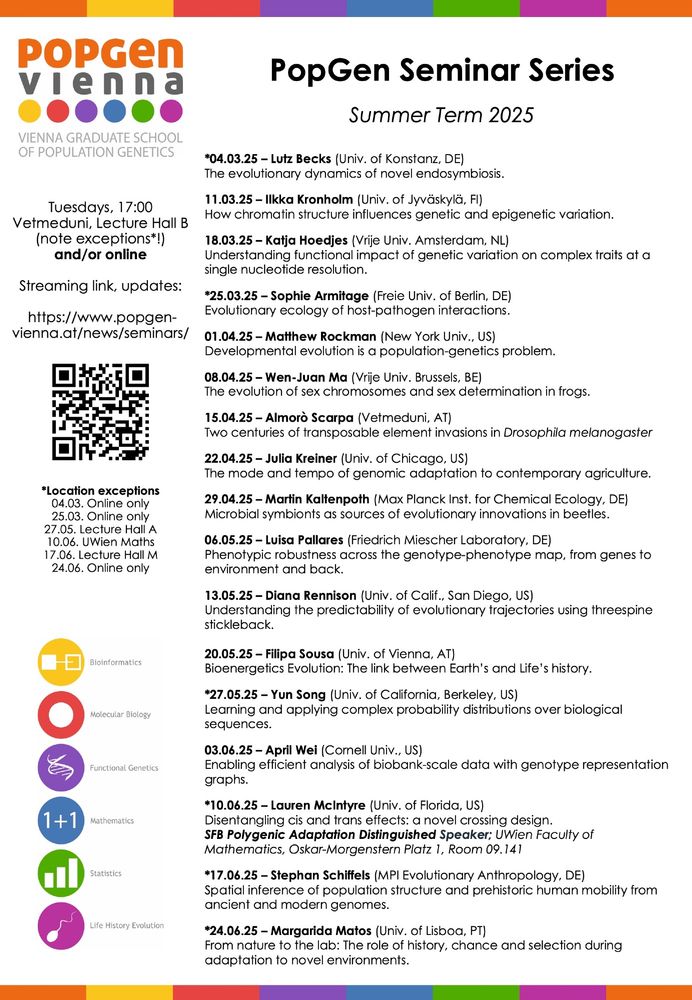
PopGen Seminar Series
Summer Term 2025
04.03.25 – Lutz Becks (Univ. of Konstanz, DE)
The evolutionary dynamics of novel endosymbiosis.
11.03.25 – Ilkka Kronholm (Univ. of Jyväskylä, FI)
How chromatin structure influences genetic and epigenetic variation.
18.03.25 – Katja Hoedjes (Vrije Univ. Amsterdam, NL)
Understanding functional impact of genetic variation on complex traits at a single nucleotide resolution.
25.03.25 – Sophie Armitage (Freie Univ. of Berlin, DE)
Evolutionary ecology of host-pathogen interactions.
01.04.25 – Matthew Rockman (New York Univ., US)
Developmental evolution is a population-genetics problem.
08.04.25 – Wen-Juan Ma (Vrije Univ. Brussels, BE)
The evolution of sex chromosomes and sex determination in frogs.
15.04.25 – Almorò Scarpa (Vetmeduni, AT)
Two centuries of transposable element invasions in Drosophila melanogaster
22.04.25 – Julia Kreiner (Univ. of Chicago, US)
The mode and tempo of genomic adaptation to contemporary agriculture.
29.04.25 – Martin Kaltenpoth (Max Planck Inst. for Chemical Ecology, DE)
Microbial symbionts as sources of evolutionary innovations in beetles.
06.05.25 – Luisa Pallares (Friedrich Miescher Laboratory, DE)
Phenotypic robustness across the genotype-phenotype map, from genes to environment and back.
13.05.25 – Diana Rennison (Univ. of Calif., San Diego, US)
Understanding the predictability of evolutionary trajectories using threespine stickleback.
20.05.25 – Filipa Sousa (Univ. of Vienna, AT)
Bioenergetics Evolution: The link between Earth’s and Life’s history.
27.05.25 – Yun Song (Univ. of California, Berkeley, US)
Learning and applying complex probability distributions over biological sequences.
03.06.25 – April Wei (Cornell Univ., US)
Enabling efficient analysis of biobank-scale data with genotype representation graphs.
ALT TEXT OUT OF SPACE, GO TO https://www.popgen-vienna.at/news/seminars/
The PopGen Vienna Seminar series schedule is ready for the next term (Mar-Jun). It's jam-packed with fantastic speakers in #evolution, #genetics, #genomics, #popgen, and more! Details and streaming link signup can be found on our website www.popgen-vienna.at/news/seminars/
13.02.2025 15:01 — 👍 11 🔁 14 💬 0 📌 1

Folge 2: Paleomycin: Wiederbelebung eines Urantibiotikums
Inside CMFI: Potenziale der Mikrobiomforschung · Episode
#Podcast Release!
🎙️Folge 2: 𝗣𝗮𝗹𝗲𝗼𝗺𝘆𝗰𝗶𝗻: 𝗪𝗶𝗲𝗱𝗲𝗿𝗯𝗲𝗹𝗲𝗯𝘂𝗻𝗴 𝗲𝗶𝗻𝗲𝘀 𝗨𝗿𝗮𝗻𝘁𝗶𝗯𝗶𝗼𝘁𝗶𝗸𝘂𝗺𝘀
Kommt mit uns auf eine Schatzsuche nach einem Millionen Jahre alten #Urantibiotikum – dringend benötigt angesichts ansteigender #Antibiotikaresistenzen.
tinyurl.com/yc7vv58j
@nadineziemert.bsky.social & Evi Stegmann
17.02.2025 10:21 — 👍 8 🔁 4 💬 1 📌 0
Join our symposium The evolution of microbial pangenomes at @eseb2025.bsky.social with @bjesseshapiro.bsky.social @annadewar.bsky.social (co-organized with @fbaumdicker.bsky.social and Jaime Iranzo)
11.02.2025 17:16 — 👍 7 🔁 6 💬 0 📌 1
We have an open position PhD position in a project aiming to develop novel methodologies for phylogenomic reconstruction of plasmid evolution. See details and how to apply in the Ad. Candidates who will review the relevant literature (see Ad) have a higher chance to write a successful application.
04.02.2025 07:57 — 👍 25 🔁 23 💬 0 📌 1

I am looking for graduate students interested in investigating bacterial genome evolution, esp. pangenomes and intergenic regions, and the relative importance of genetic drift! https://buff.ly/3UPVcQ9
21.01.2025 14:00 — 👍 6 🔁 6 💬 1 📌 0
I recently used chatGPT to create a list of people working on a certain concept. The list was quite good, but the tool refused to provide their emails (which is probably a good thing) and I did not try to provide an abstract.
21.01.2025 17:36 — 👍 1 🔁 0 💬 0 📌 0
SBI hackathon is back! Join us in Tübingen for the 4th edition, make the toolbox better, brainstorm new direction, have fun!
20.01.2025 16:45 — 👍 13 🔁 5 💬 0 📌 0
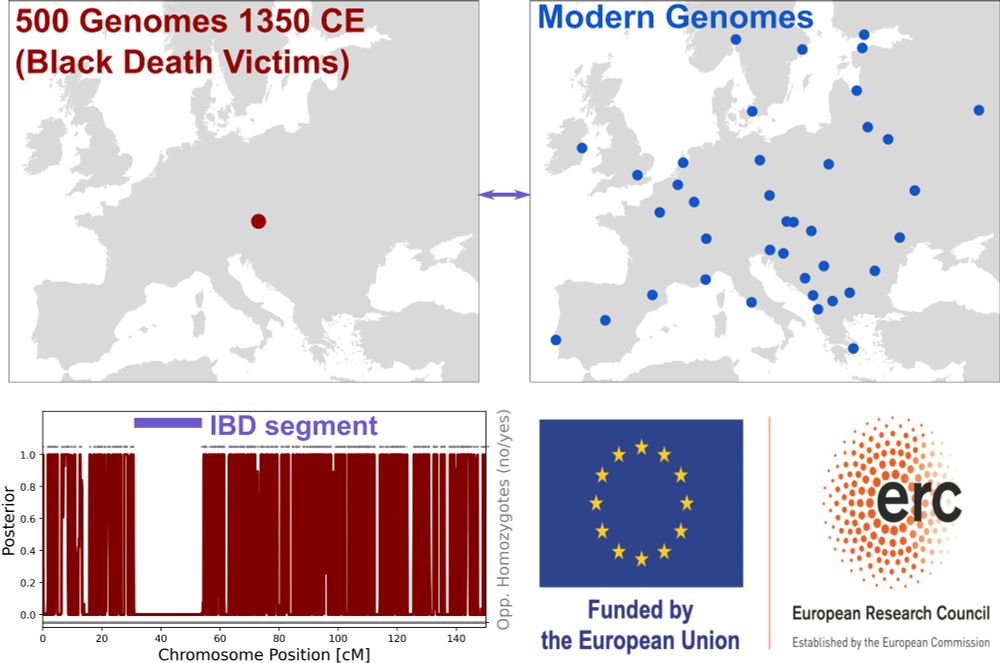
Sketch of IBD segments linking Medieval genomes from the Black Death (1350 CE) to modern Europeans. Logo of ERC-funded research.
PhD opportunity in computational population genetics at @MPI_EVA_Leipzig:
Join our fully funded project to develop IBD-segment tools, connecting high-quality genomes from 500 Black Death victims to modern Europeans. 🌍💻🧬
Please spread the word! 📢🙌 #aDNA #PopGen
www.eva.mpg.de/de/karriere/...
03.12.2024 12:52 — 👍 29 🔁 29 💬 2 📌 2
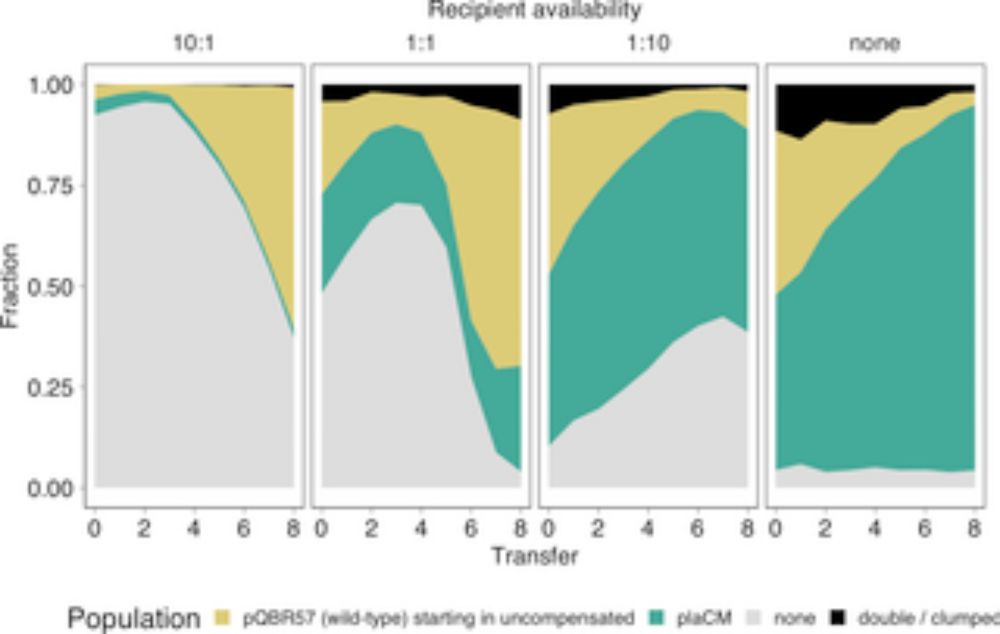
A chromosomal mutation is superior to a plasmid-encoded mutation for plasmid fitness cost compensation
Plasmids spread important traits in microbiomes but impose fitness costs on their hosts. This study of the ecological consequences of plasmid-bacterial compensatory evolution reveals benefits to bacte...
🆕New in @plosbiology.bsky.social: we show compensatory mutations make plasmids play Rock-Paper-Scissors and turn conjugation into a weapon🛡️💫✂️🦠
w/Rosanna Wright, Jamie Wood, @mbottery.bsky.social, @kmudz.bsky.social, @scottishwormboy.bsky.social, Ellie Harrison & @brockhurstlab.bsky.social #MicroSky
03.12.2024 09:45 — 👍 87 🔁 56 💬 3 📌 3
Only a few days left to apply!
28.11.2024 20:01 — 👍 1 🔁 1 💬 0 📌 0
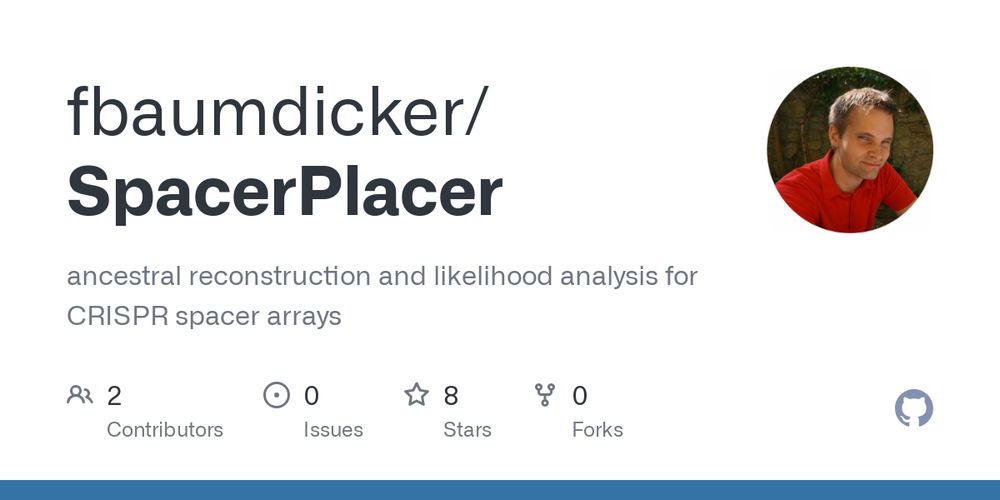
GitHub - fbaumdicker/SpacerPlacer: ancestral reconstruction and likelihood analysis for CRISPR spacer arrays
ancestral reconstruction and likelihood analysis for CRISPR spacer arrays - fbaumdicker/SpacerPlacer
It is crucial to use reconstructed arrays to see these deletion patterns in the database, as the position of spacers shifts toward the trailer end over time. I will post more details about our reconstruction tool SpacerPlacer at a later time. But you can find it here: https://buff.ly/40QdDId
20.11.2024 16:50 — 👍 2 🔁 0 💬 0 📌 0
Finally, across multiple CRISPR-Cas types and genera, we found no significant difference in deletion rates or lengths, suggesting that spacer deletions are likely not modulated by Cas proteins.
20.11.2024 16:50 — 👍 0 🔁 0 💬 1 📌 0
CRISPR spacer deletions might be more common at the leader due to
a) reconstruction errors (we correct for this)
b) mutations of the last repeat
c) recently acquired spacers lacking a long-term benefit
d) benefits of changing the spacers at the first most expressed positions
e) all of the above
20.11.2024 16:50 — 👍 1 🔁 0 💬 1 📌 0
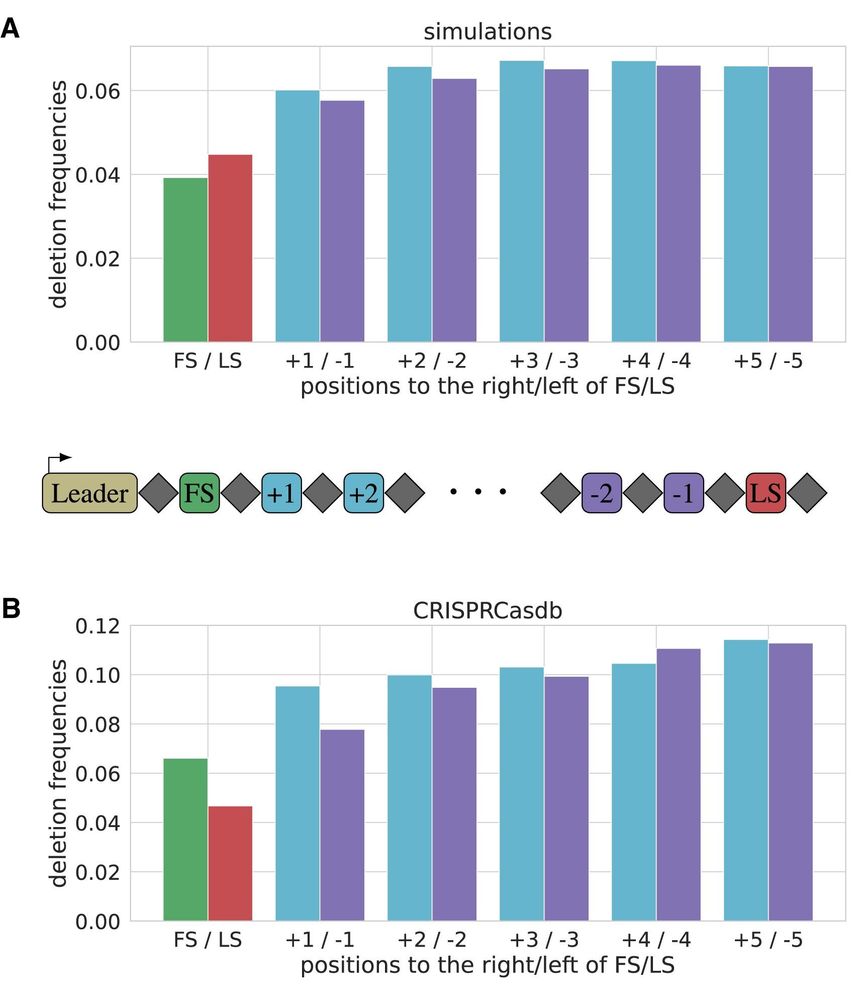
The spacer deletions at the very first and last positions of CRISPR arrays deviate from a symmetric boundary effect. The reconstructed deletion rate is higher at the first positions compared to the losses at the last positions. This might have multiple reasons ...
20.11.2024 16:50 — 👍 1 🔁 0 💬 1 📌 0
Ignoring the boundary effect, we observe no gradient of deletion frequencies along arrays. CRISPR arrays evolve surely not neutrally, but our results hint at either weak selection pressures to delete specific spacers or an equally strong selection along the array to maintain spacers. However, ...
20.11.2024 16:50 — 👍 1 🔁 0 💬 1 📌 0
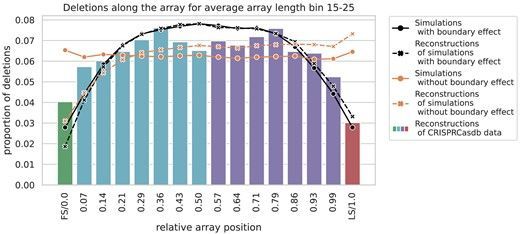
Consistent with this mechanism, we observe a “boundary effect”: Spacer deletions are less frequent near the leader and trailer ends of the array, potentially due to fewer neighboring repeats for alignment, while the middle of the array sees the most deletions.
20.11.2024 16:50 — 👍 1 🔁 0 💬 1 📌 0
Genomics, Machine Learning, Statistics, Big Data and Football (Soccer, GGMU)
| CRISPR, Plasmid Biology, Bacterial EcoEvo & AMR | Sci-Illustrator |
@embo.org postdoctoral fellow, San-Millán lab @cnb-csic.bsky.social 🇪🇸
Previously: PhD in Bikard Lab, @pasteur.fr 🇫🇷
| She/Her | From 🇪🇸 & 🇵🇹 | 💜
Genome Plasticity and Computational Genetics.
We develop cutting-edge technologies to explore genome evolution!
Lab Website: https://schneebergerlab.org/
stochastic modelling in biology, evolutionary bioinformatics, theoretical population genetics, evolutionary (epi)genomics and transcriptomics
Computational microbiologist. Senior scientist at @cemess.bsky.social, @univie.ac.at.
Microbial ecology, mostly of nitrogen cycle microbes, and data driven physiology.
Maintainer of the GlobDB genome database https://globdb.org
Machine learning in Bioinformatics - Currently @uni-hamburg.de (UHH)
https://www.zbh.uni-hamburg.de/en/forschung/mlbi.html
Postdoc in WeigelWorld @PlantEvolution, @MPI_bio. Evolution of Plant-Microbe-Microbe interactions, molecular evolution, and comparative genomics
Moonlighting as a human population geneticists in the Huerta-Sánchez Lab at Brown University, and aspiring speciation geneticists.
Welcome to the ESEB 2025 Congress, set to take place in Barcelona. This congress marks another milestone for the European Society for Evolutionary Biology (ESEB), which has been organising biennial conferences since 1987. Join us! We are waiting for you.
Evolving better E. coli for 75,000 generations. Prof at MSU, but opinions my own. (Ok, I also speak for billions -- er, TRILLIONS -- of E. coli.)
Website for LTEE: the-ltee.org
Banner pic from NYC, shared by Darwin. (The microbiologist, not the other one.)
Professor for "Machine Learning in Science", University of Tübingen.
Artificial Intellgence as a source of inspiration in Science.
https://mariokrenn.wordpress.com/
Population geneticist.
Project Scientist with Amy Goldberg 💻🧬 <- Scientist at Embark Veterinary 🐕🧬 <- postdoc with Dan Schrider 💻🧬 <- PhD in Ecology and Evolutionary Biology at the University of Arizona 💻🧬
Statistical and Population Genetics | RIKEN, iTHEMS (Japan) | 🇯🇵🇩🇪🇬🇧 |
Associate Professor of Statistical Genomics (Oxford Stats)
https://www.stats.ox.ac.uk/~ignatiev/
Studying genomics, machine learning, and fruit. My code is like our genomes -- most of it is junk.
Assistant Professor UMass Chan, Board of Directors NumFOCUS
Previously IMP Vienna, Stanford Genetics, UW CSE.
Evolution/Ecology meets Genetics @ Columbia University. We use a variety of organisms (🪰🦋🐸🪲) and approaches (mol evo and pop gen, mol bio, experimental evo, genetic engineering) to better understand constraints on adaptation.
Population and evolutionary genetics @UCDavis. Posts, grammar, & spelling are my views only. He/him. #OA popgen book https://github.com/cooplab/popgen-notes/releases















